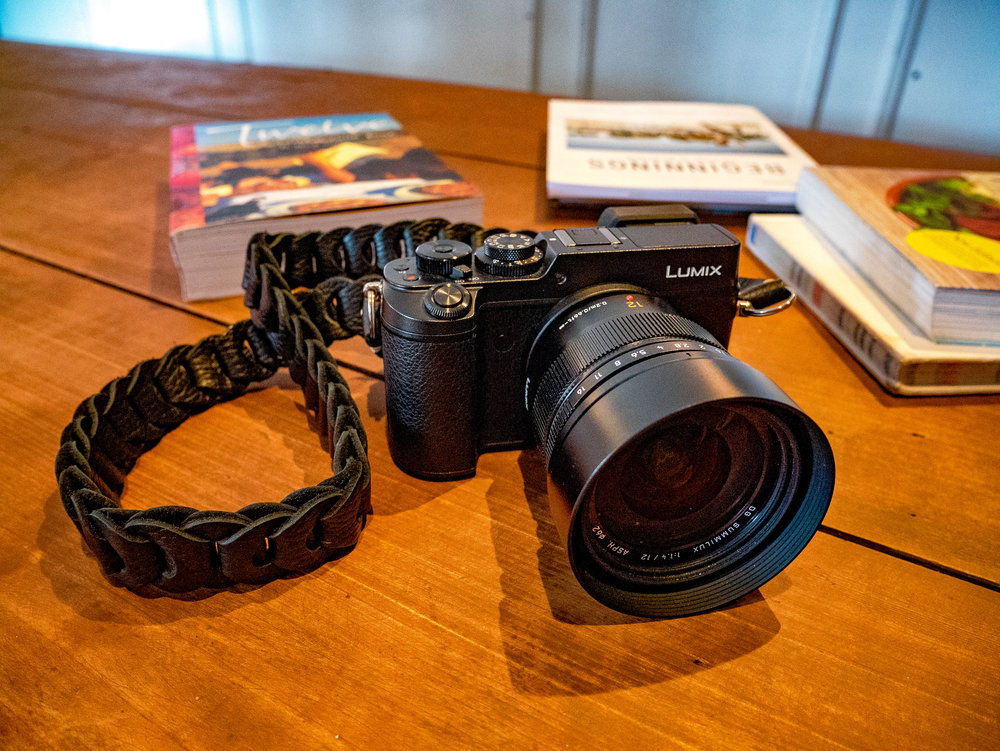
Sitting on the table in front of me is the Panasonic GX8 with a Leica 12mm DG Summilux attached. At £1,900 retail this is an expensive package for micro four thirds. But the build quality is admirable, the restrained styling is commendable. So commendable, in fact, that it reminds me of nothing more than a Leica. Swap LUMIX for LEICA and the drooling in certain quarters would commence. Yet there is no technical reason why this could not be Leica branded. After all, Leica rebrands the Panasonic LX100 (D-Lux) and the FZ-1000 (V-Lux) and both are highly regarded by Leica’s customers.
Only last week I met an experienced photographer who had a V-Lux in hand. He likes it for street photography and welcomes the huge zoom range (contrary to accepted wisdom that a prime 35 or 50mm is all you need). He believes that Leica’s tweaks to the V-Lux image processor are remarkable and he compares the camera favourable with a friend’s near-identical FZ1000. That’s as maybe, but the fact remains that there is a close collaboration between Leica and Panasonic.
DG Lenses
This cooperation extends to Leica DG lenses which, with the exception of the rather elderly 25mm f/1.4, have oodles of Leica DNA built in. The new DG Summilux 12mm f/1.4 ASPH (24mm equivalent) in the photograph is a superb example. It is as well built and certainly more “Leica like” in appearance than Leica’s own autofocus lenses.
So why does Leica not rebadge a semi professional camera such as the GX8?
The reason appears to be that Leica refuses to get involved in micro four thirds. I suspect it is more to do with the fact that m4/3 is a system with yet another lens mount. Perhaps at some stage in the past there was a worry that a Leica m4/3 system camera could cannibalise sales some of Leica’s own cameras. Another possibility is that propagation of the m4/3 programme to a third party is forbidden under the agreement between Panasonic and Olympus. This is all pure speculation but it doesn’t lessen the feeling that a Leica m/43 camera would be a good thing.
I cannot see that a m4/3-format camera would harm T or M, still less SL, but I have a glimmer of understanding of why Leica doesn’t want to muddy the waters by offering yet another system, assuming that there are no legal constraints emanating from Japan.
It is a pity. Because I believe a Leica version of this GX8 outfit would sell well, despite the inevitable Leica premium. There are enough Leica DG m4/3 primes to make the system a viable line for Leica stores and authorised resellers. Is there any hope of a change of mind?
Clues
There could be a clue in the arrival this delightful 12mm DG Summilux. It supplements the 85mm-equivalent f/1.2 Nocticron and begins to bulk out Panasonic’s premium lens range—what Olympus designates “pro”—to a point where the whole kit and caboodle could be quite a catch for the average Leica dealer. The equally new Leica DG Vario-Elmar 100-400 f/4.0-6.3 is another winner in the range, offering a stupendous 800mm reach in an ultra-compact package.
If Leica can sell the rebadged and tweaked D-Lux and the V-Lux they would certainly move this handsome GX8 and, possibly, other cameras in the Lumix range. Is it too much to hope?
Note on “DG”: I have tried without success to discover what DG stands for on the designation of Leica-branded Panasonic lenses. Panasonic’s press office tells me the DG simply means that the lens is made for micro four-thirds. This is implausible in the extreme. Knowing those Germans, it must mean something. I’ve put in a call to Leica’s press office and will update you when I get the reply.
- Subscribe to Macfilos for free updates on articles as they are published. Read more here
- Want to make a comment on this article but having problems? Please read this

Good thoughts Mike… I wonder whether you are near the truth when you refer to some kind of agreement between Olympus and Panasonic regarding licensing of the MFT format… Indeed could this be why the D-Lux is referred to as merely ‘four thirds’? I would be willing to bet that the sensor is in fact MFT… Remember that the D-Lux has some rather odd selectable picture formats and none of them employ the full capability of the sensor in the camera!
Having said that, although I am a mere amateur compared to yourself Mike when it comes to acquiring new gear…
…That apart from my current arrangement with the Leica M-P, along with the beautiful new Summicron that I have just collected… The best camera that I have ever used previously, was my Panasonic LX100… The one that started the higher quality compact craze…
I am waiting for the next D-Lux and I may jump aboard.
I am not at all sure about the difference between four thirds (which was a film standard) and micro four thirds. Nor do I fully understand those peculiar crop figures. I remember that the D-Lux/LX-100 has a crop factor of 2.2 rather than the 2 of normal MFT cameras. I also remember talking to Stefan Daniel at the launch of the D-Lux when he was quick to correct me when I said this was an MFT sensor. It is four thirds, not micro four thirds he said with conviction. This could lend weight to our theory that Panasonic is precluded from offering any part of the MFT system to third-party manufacturers. In fact, I think this is the real reason we don’t have a Leica GX8.
An updated D-Lux will be interesting. Even though it might not appear next week, I am fairly certain we will see the LX-100 upgrade and that, of course, will set the scene for the new D-Lux whenever it appears.